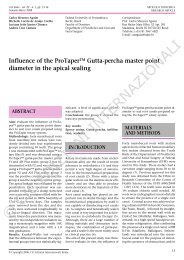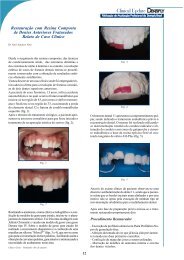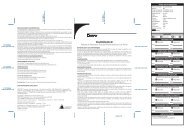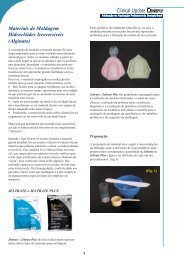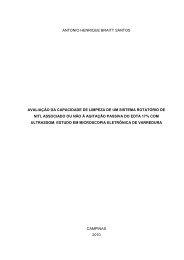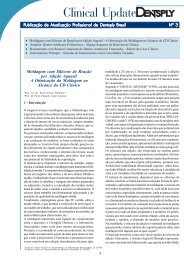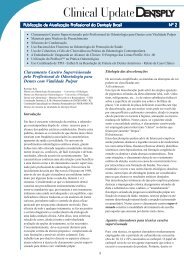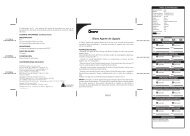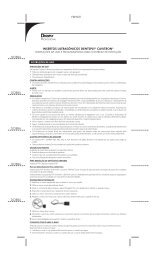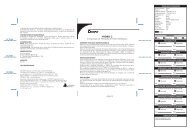You also want an ePaper? Increase the reach of your titles
YUMPU automatically turns print PDFs into web optimized ePapers that Google loves.
Blunck/Zaslansky<br />
Table 1 Tested adhesive system/composite resin combinations<br />
Group Adhesive system Composite resin Adhesive manufacturer<br />
Multi-bottle systems Syntac Artemis Ivoclar Vivadent; Schaan,<br />
(control)<br />
Liechtenstein<br />
OptiBond FL Herculite XR Kerr; Danbury, CT, USA<br />
Clearfil SE Bond Clearfil AP-X Kuraray; Tokyo, Japan<br />
All-in-one Prompt L-Pop 1999 Tetric Ceram ESPE; Seefeld, Germany<br />
adhesive systems Prompt L-Pop 2000 Tetric Ceram ESPE<br />
with mixing Adper Prompt L-Pop Tetric Ceram 3M ESPE; St Paul, MN, USA<br />
Adper Prompt L-Pop Filtek Z250 3M ESPE<br />
Futurabond NR Grandio Voco; Cuxhaven, Germany<br />
One-up Bond F Estilite Tokuyama; Tokyo, Japan<br />
Xeno III Tetric Ceram <strong>Dentsply</strong> DeTrey; Konstanz, Germany<br />
Xeno III Dyract eXtra <strong>Dentsply</strong> DeTrey<br />
Xeno III Quixfil <strong>Dentsply</strong> DeTrey<br />
All-in-one AQ Bond Metafil CX Morita; Irvine, CA, USA<br />
adhesive systems G-Bond Gradia GC; Tokyo, Japan<br />
without mixing Hybrid Bond Metafil Morita<br />
iBond Charisma Heraeus Kulzer, Hanau, Germany<br />
tri-S bond Clearfil AP-X Kuraray<br />
plying multi-bottle or one-bottle adhesives, and self-etching<br />
systems that contain acid monomers which can condition<br />
both enamel and dentin simultaneously with no rinsing. 36<br />
Self-etching adhesive systems can be applied in two consecutive<br />
steps or as so-called all-in-one adhesives. The latter<br />
are available in two forms: those that require mixing and<br />
those that do not.<br />
The effectiveness of adhesive systems can be tested in<br />
vitro by bond strength measurements of various kinds, by<br />
penetration tests of Class V/II fillings with different substances,<br />
and by evaluating the margin quality of Class I/II/V<br />
or cylindrical fillings under a microscope. 17 In this study, visual<br />
inspection of discontinuities at the margins was performed<br />
using a scanning electron microscope (SEM), dedicated<br />
to the identification and quantification of dental margin<br />
qualities. 26 This method has several advantages, such<br />
as the high level of detail revealed and marked accuracy, allowing<br />
it to be used for evaluating the same margins at different<br />
times. This is particularly useful for testing the effects<br />
of water storage or stress on the same specimens.<br />
This paper considers the effectiveness of all-in-one adhesive<br />
systems in comparison to reference multi-bottle adhesive<br />
systems, as judged by evaluating the marginal integrity<br />
in dentin and enamel after different periods of water<br />
storage. The effects of short- vs long-term storage were exemplified<br />
by applying thermal stress in order to expose marginal<br />
degradation differences. This was used to study the<br />
state of the restoration margins at 3 weeks, 1 year and 3<br />
years, and consider some aspects of the dynamics of adhesive<br />
aging.<br />
MATERIALS AND METHODS<br />
This work reflects the current status of a large ongoing study.<br />
Teeth, anonymously collected following routine dental treatment,<br />
were stored in 0.1% thymol solution at room temperature<br />
prior to and during the experimental period. One hundred<br />
thirty-six caries-free extracted human anterior teeth<br />
were used, and typical Class V cavities were prepared with<br />
a diamond bur (diamond bur No. 838/314/014; Gebr. Brasseler;<br />
Lemgo, Germany) at high speed using water as a<br />
coolant. Oval preparations were a standard size: approximately<br />
4 mm high, 1.5 mm deep, and 3 mm wide (2 mm apical<br />
to the cementoenamel junction spanning across the CEJ<br />
and into enamel). The enamel portions were bevelled with a<br />
finishing diamond bur (Composhape H-15, Intensiv; Viganello-Lugano,<br />
Switzerland) and the cavosurface margins<br />
in dentin finished to a 90-degree angle with a finishing diamond<br />
(No. 8838/314/012, Gebr. Brasseler). The teeth were<br />
randomly divided into 17 groups of 8 teeth each.<br />
Each group of teeth was assigned to one of 17 treatments.<br />
These included 14 combinations of all-in-one adhesive<br />
system/composite resins and three multi-bottle adhesive<br />
systems (Syntac and OptiBond FL, etch-and-rinse technique,<br />
and Clearfil SE Bond, self-etching technique). The adhesives<br />
were all applied and restored with composite resin<br />
according to the manufacturer’s instructions as detailed in<br />
Table 1. In an attempt to ensure optimal performance of the<br />
adhesives, the composite used was generally that recommended<br />
by the adhesive manufacturer, although for some<br />
of the adhesives (Adper Prompt L-Pop and Xeno III), several<br />
232 The Journal of Adhesive Dentistry



